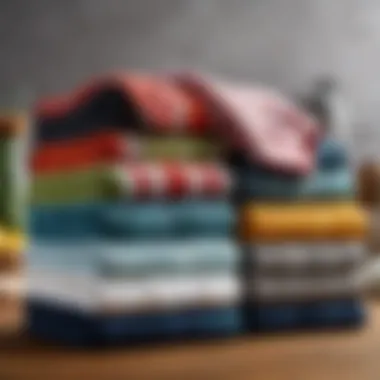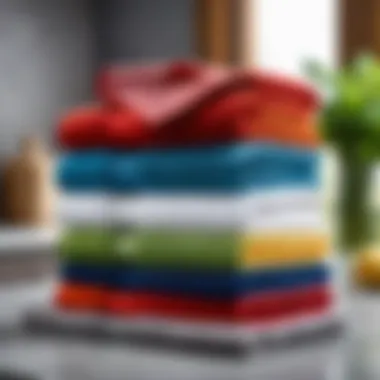A Comprehensive Guide to Kitchen Towel Sets


Intro
When navigating the kitchen landscape, the importance of kitchen towel sets becomes apparent. These seemingly simple accessories play a crucial role in both functionality and aesthetics. Selecting the right set can greatly influence your kitchen's organization and overall vibe. This article aims to explore the various aspects of kitchen towel sets, from material preferences to care instructions, and provide consumers with practical insights for making informed choices.
Актуальные акции и скидки
Обзор текущих предложений
As consumers look for ways to enhance their kitchen experience, keeping an eye on current promotions is essential. Many retailers often offer discounts on kitchen towel sets, allowing for savings while upgrading your kitchen supplies. Websites like Amazon and Walmart frequently feature seasonal sales that include kitchen textiles. Checking these platforms regularly can yield valuable deals for the budget-conscious shopper.
Специальные предложения от популярных брендов
Several renowned brands may have ongoing deals that appeal to a wide audience. Brands such as Utopia Kitchen, kitchenAid, or Williams Sonoma may provide promotional prices on selected towel sets. It is beneficial to subscribe to newsletters or programs to receive notifications about special offers. Often, these brands provide exclusive deals to their subscribers, further incentivizing the shopper to stay informed.
Types of Kitchen Towel Sets
Understanding the different types of kitchen towel sets is essential for any shopper. Here is a simple breakdown:
- Dish Towels: Used primarily for drying dishes, these towels are usually made from cotton or a cotton blend. They are highly absorbent and soft.
- Microfiber Towels: These are known for their durability and ability to trap dust and dirt effectively.
- Tea Towels: A versatile choice, tea towels can serve multiple purposes including drying dishes, as table linens, or as a decorative element.
- Paper Towels: Though disposable, they are widely used for quick clean-ups and food spillage.
Choosing the right type aligns with kitchen tasks and personal preferences.
Material Benefits
The materials of kitchen towel sets fundamentally affect their performance and longevity.
- Cotton: Highly absorbent and easy to clean, cotton towels can withstand multiple washing and maintain their quality over time.
- Linen: Known for its strength and durability, linen towels dry quickly and resist bacteria growth.
- Bamboo: Sustainable and eco-friendly, bamboo towels possess antibacterial properties and are soft to the touch.
Each material comes with its own set of benefits, woven into the fabric of everyday kitchen life.
Care Instructions
Proper care extends the life of kitchen towel sets. Here are key points to remember:
- Washing: Most towels can be machine washed in warm water but check care labels for specifics.
- Drying: It is usually fine to tumble dry on low, yet air-drying can preserve towel integrity longer.
- Bleaching: Avoid bleach as it can weaken fibers and change colors. Instead, consider natural alternatives like vinegar for stain removal.
Attention to care makes a significant difference in maintaining quality and cleanliness.
Impact on Kitchen Organization and Aesthetics
Kitchen towels serve as functional objects but also offer a chance to express style. The choice of colors, patterns, and designs can enhance the overall look of a kitchen. Coordinating towels with existing decor or seasonal themes can create a cohesive environment that is stylish and inviting.
Understanding Kitchen Towel Sets
Kitchen towel sets are vital tools in any culinary environment. Understanding their significance is crucial for maintaining a functional and organized kitchen. The right set of towels can enhance efficiency while cooking, cleaning, and maintaining hygiene. They come in various materials and types, each serving specific purposes. Knowing these details allows consumers to make informed choices that align with their needs and styles.
Definition and Purpose
Kitchen towels serve multiple functions in the kitchen. They assist in drying dishes, handling hot cookware, and even cleaning spills. The choice of a suitable towel can enhance the cooking experience. Additionally, kitchen towels also contribute to the aesthetics of the kitchen space. They are often an overlooked part of kitchen organization that can affect both utility and appearance.
Types of Kitchen Towels
Kitchen towels are categorized into several types, each with unique characteristics.
Dish Towels
Dish towels are primarily used for drying dishes and glassware. They are typically made from cotton or a cotton blend, making them absorbent and soft. Their key characteristic is high absorbency, which allows for efficient drying. Dish towels tend to be a popular choice due to their utility in managing clean-up after dishwashing tasks. However, they may require frequent laundering, which is a consideration for maintainance.
Tea Towels


Tea towels are often more decorative than functional. They usually come in various designs and colors, adding style to the kitchen. Their primary use is for drying dishes and covering food items. Tea towels are generally made from cotton or linen, contributing to their absorbent qualities. While their aesthetic appeal is a notable advantage, they might not be the best choice for heavy-duty drying tasks compared to dish towels.
Hand Towels
Hand towels are essential for kitchen hygiene. They are commonly used to dry hands after washing. These towels may vary in size compared to dish and tea towels. The key characteristic of hand towels is their compact size, which makes them easy to use and store. They should be washed regularly to prevent bacterial growth. Their role in maintaining hygiene cannot be overstated, making them a must-have in any kitchen.
Microfiber Towels
Microfiber towels are known for their cleaning efficiency. Made from synthetic fibers, they excel in absorbing liquid and wiping surfaces. The unique feature of microfiber towels is their ability to trap dirt and grease effectively. They tend to be more durable than cotton towels, which is an advantage in the long run. However, some users may find they do not dry dishes as well as others, so it's important to evaluate their use carefully.
Understanding these different types of kitchen towels is essential. Each has its specific appeal and utility, depending on individual kitchen needs.
Materials Used in Kitchen Towels
The materials used in kitchen towels play a pivotal role in their performance and longevity. Choosing the right fabric affects how well they dry dishes, endure daily wear, and maintain hygiene in the kitchen. Additionally, the material can influence how towels feel to the touch and their overall aesthetic. In today's market, kitchen towels are available in various materials, each offering unique advantages and disadvantages. Understanding these can aid in selecting the best towels for your specific needs.
Cotton: The Traditional Choice
Cotton has long been the go-to material for kitchen towels. Its absorbent nature makes it particularly effective for drying dishes and wiping surfaces. People tend to favor cotton due to its softness and comfort, allowing for easy handling and extended use without discomfort. Moreover, cotton towels are generally easy to wash and maintain; they can withstand high temperatures in washing machines.
When purchasing cotton kitchen towels, it’s essential to look for ones made from 100% cotton, as blends can reduce absorbency and feel rougher on skin. Cotton towels are also available in various patterns and colors, making them versatile for different kitchen styles. Their durability translates into a longer lifespan, which can be economically favorable in the long run.
Linen: The Luxurious Alternative
Linen is often regarded as a more luxurious option compared to cotton. This fabric, derived from flax plants, is known for its exceptional absorbency and rapid drying capabilities. Linen towels do not harbor bacteria easily, making them more hygienic. Additionally, they resist the formation of lint. Though linen tends to be pricier than cotton, many find its durability and elegance worthwhile.
One downside is the initial stiffness of linen towels. They may require multiple washes to soften fully. However, over time, they become increasingly cozy. Notably, linen has a unique texture that lends a delicate charm to any kitchen setup, appealing to those who value aesthetics.
Microfiber: The Modern Solution
In recent years, microfiber has emerged as a favored material for kitchen towels. Comprising ultra-fine synthetic fibers, this material boasts impressive absorbency and enables efficient cleaning without scratching surfaces. Microfiber towels excel in absorbing spills and grease, making them suitable for a busy kitchen environment.
They are lightweight and compact, making storage easy. Some people appreciate that microfiber towels dry quickly and require less frequent washing due to their resistance to odor. However, it’s crucial to note that not all microfiber towels are created equal; quality can vary significantly, so it is wise to choose reputable brands. Microfiber may lack the warmth of natural fabrics, which is a consideration for those who prefer traditional kitchen linens.
Key Takeaway: Choosing the right material for your kitchen towels can significantly enhance your cooking and cleaning experience. Whether you opt for cotton, linen, or microfiber, understanding the strengths and weaknesses of each fabric will help you make informed choices.
Functional Roles of Kitchen Towels
Kitchen towels are often overlooked in the grand scheme of kitchen tools, yet their roles are paramount. They do more than add aesthetics to kitchen spaces; they offer functionality that enhances various cooking and cleaning tasks. Understanding these roles is essential for any aspiring chef or home cook. Kitchen towels serve vital purposes such as drying dishes efficiently, handling hot cookware, and maintaining hygiene.
Drying Dishes Efficiently
One of the primary functions of kitchen towels is drying dishes. After washing, dishes must be dried to prevent water spots and streaks, especially on glassware. A good kitchen towel can absorb water quickly. For example, cotton dish towels are designed for this very task. Their absorbent nature allows you to dry multiple dishes without needing to wring them out repeatedly.
Using appropriate towels for drying helps maintain the integrity of crockery. Delicate materials like china often require gentle care, which can be compromised by using rough or inappropriate fabrics. When selecting towels specifically for drying, opting for those with a more substantial weave offers better durability.
Handling Hot Cookware
Another critical role of kitchen towels is handling hot cookware. Oftentimes, pots and pans can reach high temperatures that may cause burns. Here, thick cotton or specialized potholders are necessary. These towels should provide insulation, allowing you to grasp hot handles or remove hot dishes from the oven safely.
It's essential to avoid using thin or damp towels for this purpose. They may not provide adequate protection and could result in kitchen accidents. Therefore, investing in quality towels can ensure safety in the kitchen.
Maintaining Kitchen Hygiene
Kitchen towels are also crucial in maintaining hygiene. They can harbor bacteria if not cared for properly. As you clean surfaces and handle food, using clean towels is essential to avoid cross-contamination. For instance, if a towel is used to wipe up raw meat juices, it should not be used again until it has been washed.
Regularly washing kitchen towels is highly advisable. Many kitchen professionals recommend washing towels with hot water and detergent to eliminate bacteria effectively. It’s also prudent to have several sets on hand, allowing you to always have a clean towel when needed.
Kitchen towels serve multiple functions, and understanding these roles can optimize their use in everyday cooking and cleaning tasks.


In summary, the functional roles of kitchen towels range from drying and handling to hygiene maintenance. These aspects are vital not only to enhance the cooking experience but also to ensure safety and cleanliness within the kitchen. By recognizing how to use kitchen towels effectively, individuals can encourage a more organized and efficient kitchen.
Selecting the Right Kitchen Towel Set
Choosing the right kitchen towel set is a crucial aspect of organizing your kitchen effectively. Kitchen towels serve more than a functional purpose; they can elevate the overall aesthetic of your space. By selecting the right towels, you ensure that your kitchen remains not only efficient but also stylish. This section will discuss key elements to consider when selecting a kitchen towel set, shedding light on the benefits and considerations involved in making an informed choice.
Consider Your Needs
Before jumping into a purchase, reflect on your specific requirements. What tasks do you use towels for most? Determine if your primary need is drying dishes, handling hot cookware, or maintaining hygiene surfaces. Understanding your daily routines helps select towels that cater directly to those tasks. For instance, if you often find yourself drying dishes, then a set of high-absorbency cotton dish towels would serve you best.
- List of needs:
- Drying: Look for absorbent materials.
- Handling: Choose thicker varieties for better heat protection.
- Cleaning: Consider microfiber for effective dirt removal.
Identifying your needs sets the foundation for further refinement.
Evaluating Material Quality
The quality of the materials used in kitchen towels directly influences their durability and effectiveness. When selecting your kitchen towel set, you should assess what materials are most suited to your tasks. Cotton remains a popular choice due to its absorbency and softness. Linen offers a touch of luxury and is durable, but may not absorb as much liquid. Microfiber excels at absorbing moisture and dirt without scratching surfaces.
Consider these pointers when evaluating material quality:
- Check woven intricacy: A tighter weave usually equals better durability.
- Look for labels stating "100% cotton" or other pure materials for best results.
- Read product reviews to gauge the long-term performance of different materials.
Assessing Size and Thickness
The dimensions and thickness of kitchen towels should align with your usage patterns. Standard kitchen towels usually measure around 15x25 inches; however, sizes can vary. Thicker towels provide greater absorbency as well as better protection when handling hot pots and pans.
Keep these factors in mind:
- Thicker towels are better for heat resistance but may require more drying time.
- Opt for larger sizes if you frequently work with big pots or large quantities of dishes.
- Smaller towels can be useful for quick tasks or as decorative accents in your kitchen.
Design and Color Coordination
While functionality is the primary concern when choosing kitchen towels, design cannot be entirely overlooked. A cohesive color palette and design can enhance your kitchen decor. Selecting colors that match your kitchen's theme provides visual harmony. You can opt for neutral colors or bold patterns, depending on your style preference.
- Popular design options include:
- Minimalist patterns for a sleek appearance.
- Bold colors to add a pop to a neutral kitchen.
- Seasonal themes for a festive touch.
Choosing the right kitchen towels can influence both the aesthetics and functionality of your kitchen.
Care and Maintenance of Kitchen Towels
Kitchen towels play crucial roles in daily cooking and cleaning activities. Understanding their care and maintenance ensures they remain effective and hygienic over time. Proper care also extends the life of the towels, making them a worthwhile investment. Here, we will discuss how to wash, dry, and store kitchen towels effectively.
Washing Instructions
Washing kitchen towels may seem simple, but there are specific guidelines that can enhance their cleanliness. First, it is key to wash towels separately from other laundry items. This helps prevent cross-contamination from other fabrics, especially if they are being washed after handling food. Most kitchen towels can be machine washed in warm or hot water. Selecting a cycle that adequately cleans while being mindful about energy use can be beneficial.
In terms of detergent, it is advisable to use a mild, unscented detergent. This avoids any possible flavor transfer during cooking and keeps the towels free of harsh chemicals. Adding white vinegar to the wash can also help eliminate odors and maintain brightness. However, avoid bleach as it can degrade the fabric over time. Finally, ensure the towels are completely dry before storing them to prevent mildew growth.
Proper Drying Techniques
Drying kitchen towels properly is as important as washing them. Ideally, towels should be air-dried whenever possible. Hanging them out in fresh air allows for natural evaporation of moisture, which inhibits bacterial growth. If using a dryer, select a low to medium heat setting. Overdrying can lead to wear and tear of the fabric.
Additionally, make sure to turn the towels inside out before drying. This exposes the inner fibers, which can help in absorbing more moisture during use. If towels seem stiff after drying, consider throwing them in the dryer with a few dry tennis balls. This can help fluff up the fabric and restore its absorbency.
Storage Solutions


Storing kitchen towels correctly preserves their condition and keeps them accessible. It is ideal to fold them neatly and store them in a designated drawer or on a shelf. Avoid cramming them into tight spaces, as this can lead to creasing and unnecessary wear. Instead, a simple basket or bin can create a visually appealing arrangement and make retrieval easier.
Alternatively, displaying towels by hanging them on hooks or rails can add to the kitchen's aesthetic appeal. This method also allows for quick access while cooking or cleaning. If your kitchen design allows, consider using a decorative rack that matches your décor, turning a practical solution into a stylish element of the kitchen.
Proper care of kitchen towels not only keeps them fresh and clean but also enhances the overall hygiene of your kitchen.
The Cost Implications of Kitchen Towel Sets
Understanding the cost implications of kitchen towel sets is crucial for both budget management and the long-term benefits they offer. Many consumers overlook this aspect, focusing solely on aesthetic appeal or functionality. However, the price range of kitchen towels can significantly reflect their quality, longevity, and effectiveness in everyday use. A well-thought-out purchase can save money in the long term while enhancing the kitchen's overall efficiency and presentation.
When considering kitchen towel sets, it is essential to balance quality with budget constraints. Quality towels tend to perform better and last longer, reducing the frequency of replacements. This idea dovetails with financial sense as investing a bit more upfront can lead to fewer purchases over time.
"Choosing the right kitchen towel set is not just about the initial cost, but also about the value you derive from its use over time."
Budget-Friendly Options
Budget-friendly kitchen towel sets are available without compromising functionality or style. There are several strategies consumers can adopt to find affordable options:
- Look for Sales: Many retailers offer discounts during certain times of the year, such as holidays or store anniversaries.
- Buy in Bulk: Purchasing larger sets can reduce the cost per towel. Retailers often offer attractive discounts for bulk purchases.
- Check Online Deals: E-commerce platforms often have special deals or promotions. Websites like Amazon frequently update their offers on kitchen supplies.
- Consider Store Brands: Many store brands provide quality towels at a lower price point compared to name brands.
- Shop Second Hand: Thrift stores and clearance sales can yield excellent finds, perfectly functional items at a fraction of the price.
These approaches can help you acquire a comprehensive set of towels without extensive financial strain, ensuring your kitchen remains functional and organized without overspending.
Investing in Quality
While budget-friendly options can be appealing, investing in high-quality kitchen towel sets often yields more advantageous results. Here are some key factors to consider when selecting premium towels:
- Durability: Higher-priced towels usually offer superior durability. They withstand frequent washing and are less prone to wear and tear.
- Absorbency: Quality towels made from premium materials such as cotton and linen typically have better absorbency. This feature is essential for drying dishes efficiently and handling spills.
- Design and Aesthetics: Often, quality towels come with distinctive designs or patterns. This can elevate kitchen decor and contribute to a cohesive home aesthetic.
- Safety and Hygiene: Investing in good kitchen towels can also enhance safety. Towels that dry quickly and resist bacteria are invaluable in maintaining a healthy kitchen environment.
- Long-term Savings: Although the initial investment may be higher, good quality towels can lead to fewer replacements, translating into savings over time.
Eco-Friendly Kitchen Towels
As more consumers prioritize sustainability, the demand for eco-friendly kitchen towels has surged. These towels not only serve traditional functions but also play a role in reducing our environmental footprint. In this segment, we will explore the significance of eco-friendly kitchen towels and how they contribute to a responsible lifestyle.
Sustainable Materials
The first aspect to consider in eco-friendly kitchen towels is their material composition. Many brands now use organic cotton, bamboo, or hemp. Organic cotton is cultivated without harmful pesticides or fertilizers, which nourishes the soil and protects ecosystems. Bamboo, on the other hand, grows quickly and requires fewer resources, making it a renewable option.
Moreover, hemp is gaining popularity due to its natural durability and minimal water needs during cultivation. Using these sustainable materials ensures that the production process is less damaging to the environment. When choosing kitchen towels, look for certifications like Global Organic Textile Standard (GOTS) or OEKO-TEX.
These labels guarantee that the product meets rigorous environmental and social standards throughout its lifecycle.
Reducing Waste
Reducing waste is another crucial benefit of opting for eco-friendly kitchen towels. Traditional kitchen towels often end up in landfills, where they contribute to long-lasting waste issues.
By investing in reusable towels made from sustainable materials, you can significantly lower your environmental impact. A single set of durable kitchen towels can replace hundreds of paper towels over time.
"By switching to reusable options, households can save money and resources in the long run."
Additionally, many eco-friendly kitchen towels are designed to be compostable, meaning they can return to the Earth at the end of their life cycle.
End
The conclusion of this article carries significant weight as it encapsulates the many insights discussed regarding kitchen towel sets. Understanding the topic fully allows readers to make more informed decisions when selecting towels for their kitchens. Kitchen towels might seem like a trivial part of kitchen supplies, yet they play a crucial role in both functionality and style.
Summary of Key Points
- Diversity of Types: Each type of kitchen towel serves a distinct purpose, such as drying, handling hot items, or maintaining hygiene. Knowing these differences allows for optimal selection based on specific needs.
- Material Matters: Materials like cotton, linen, and microfiber provide unique benefits. Cotton offers absorbency, linen brings luxury, and microfiber delivers modern efficiency. Each material has its own care requirements and durability.
- Care Instructions: Proper care enhances the lifespan of kitchen towels. Following specific washing and drying guidelines will keep towels fresh and effective.
- Cost Considerations: There are options available across various price points, allowing anyone to find a suitable set whether on a budget or looking to invest in high quality.
- Eco-Conscious Choices: With increasing concern for the environment, choosing sustainable materials and products can help reduce waste. This aligns consumers with eco-friendly practices.
Final Thoughts on Choosing Kitchen Towels
In the end, the choice of kitchen towels is not only practical but also influences the overall aesthetic of the kitchen. When selecting a towel set, consider both functionality and visual appeal.
"The right kitchen towel can bring both efficiency and style to your kitchen, making the everyday tasks a bit more enjoyable."
Think about your home environment and how each design fits into it. Versatile designs can complement various kitchen styles, enhancing the space without compromising utility. Ultimately, informed choices lead to satisfaction and better organization in your cooking area.



